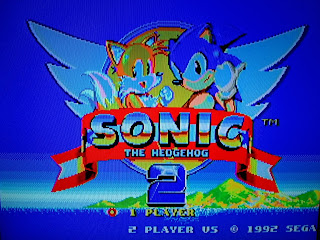Here it is now, sitting atop my increasingly cluttered project table. As the model number suggests, the 910MP is a multi-purpose display, doing double duty as a computer monitor and a television set. Sure, most modern television sets offer the same functionality, but can they do this?
Feast your eyes on the back of the set. Yes, that's a SCART cable... you won't need a converter because the 910MP has a port built right into it. This is one of the few televisions released here in America that's compatible with SCART, a European display standard that offers composite, RGB, and audio signals all in one cable. The numerous pins packed into SCART gives it the convenience and versatility most American display standards can't match, and it's a little bewildering that it never caught on here. Sure, that connector is pretty big, but it's no larger than the five plugs you'd need for a component connection with stereo sound.
Ah, but there's a catch. The SCART connector won't work until you jump into the menu and program the 910MP to work as a European television. After you've done this, it won't pick up any analog television signals, but since America is no longer receiving any, that's only going to be a problem if you've got a time machine set for the year 2003.
Now that you've got your SCART cable and a television that can recognize it, it's time to experience video games the way Europeans have for decades. Drum roll, please!
Well, that was a little anti-climactic. The picture is better than composite, but it's not the quantum leap forward I was expecting. The colors are more vibrant and the pixels are sharper, but brightness and contrast are an issue. Notice the wings on either side of the logo... they should be dazzlingly bright, but here, it looks like someone at Samsung was doing laundry and forgot to throw in a cap full of bleach. It's dingy, lifeless, unremarkable. The same goes for Tails' chest fluff and Sonic's cartoon gloves. While you can adjust the colors in the options menu, no setting I've tried will get the whites in Genesis games their whitest.
However, in the 910MP's defense, it offers good pixel separation. Observe the checkerboard pattern of blue against light blue in the background. On a composite television, the two colors would merge, creating a gradient effect. Here, they're clearly defined as separate colors, making the game look a bit more like it would in an emulator. Also, props to the 910MP for including a "still" button which freezes the picture, making it easier to take snapshots like this.
Let's move on to Streets of Rage 2; specifically the character select screen. The 910MP faithfully reproduces much of the extreme detail in each hero's portrait, but loses some of the more minute features. We'll bring the camera in for a closer look.
You notice the chin stubble and the Ferrigno-like features of the game's massive wrestler Max, but Axel's blue eyes, already barely noticeable in an emulator, are gone completely, merging with nearby pixels to become nearly black. This blending becomes an issue with smaller objects like sprites. Here's how Axel looks in the first stage of the game...
The shine on Axel's cheek nearly swallows his whole face! Once again, whites are toned down significantly, an especially bitter pill when you open the 910MP's menu and notice the clean white header bars on the top of the dialog box. This television is capable of strong luma output... just not in any devices connected to the SCART port.
Okay, one last image before I wrap this up. This comes from Accolade and PF Magic's Ballz, an early 3D fighting game that doubles as a time capsule of mid 1990s gaming trends. Check out the random video clips and the rude messages on the televisions in the background! It's so exxxtreme™ it hurts!
Anyway. There's a bit of ghosting on the rhinoceros, but I'm not sure if that's from the television or just my smartphone's camera. The 910MP handles scrolling fairly well... there's occasional screen tearing but at least the sprites don't get that blurry filtered look like they do on the CiBest SCART to HDMI converter.
Am I satisfied with the Samsung 910MP? Erm... not really. It doesn't deliver the quality picture you'd expect from a flat screen display with an RGB port, even one edging fifteen years of age. I'm told the culprit is de-interlacing... anything fed through the SCART port is processed before it's displayed, resulting in a slightly soft and dull picture. It's better than composite, as you'll notice from the pictures below, but it still isn't where it ought to be.
 |
| Composite |
 |
| RGB SCART |










Are you positive your SCART cable is RGB? SCART connectors can carry a wide range of connections ranging from composite on up. It's possible you might just be running a composite connection here rather than a true RGB connection.
ReplyDeleteIt's possible. It looks like all the pins are there, though. I could always run a test with my multimeter to see what goes where!
DeleteJust tested the R, G, and B pins on both ends of the cable. They read, but at extremely high resistance values (8 to 17 megaohms). I presume that's by design... I also used this cable with a SCART to HDMI converter, and while I wasn't satisfied with the picture, it certainly wasn't composite quality.
Delete